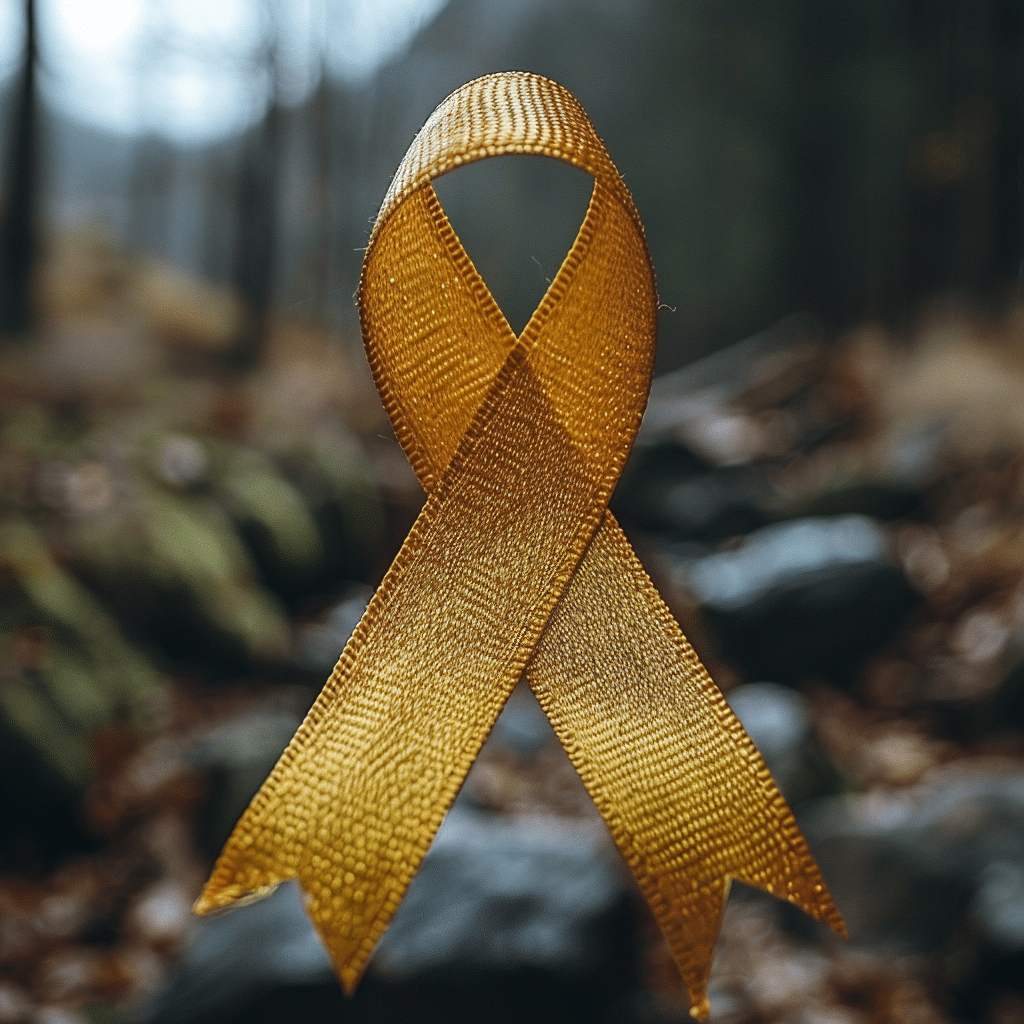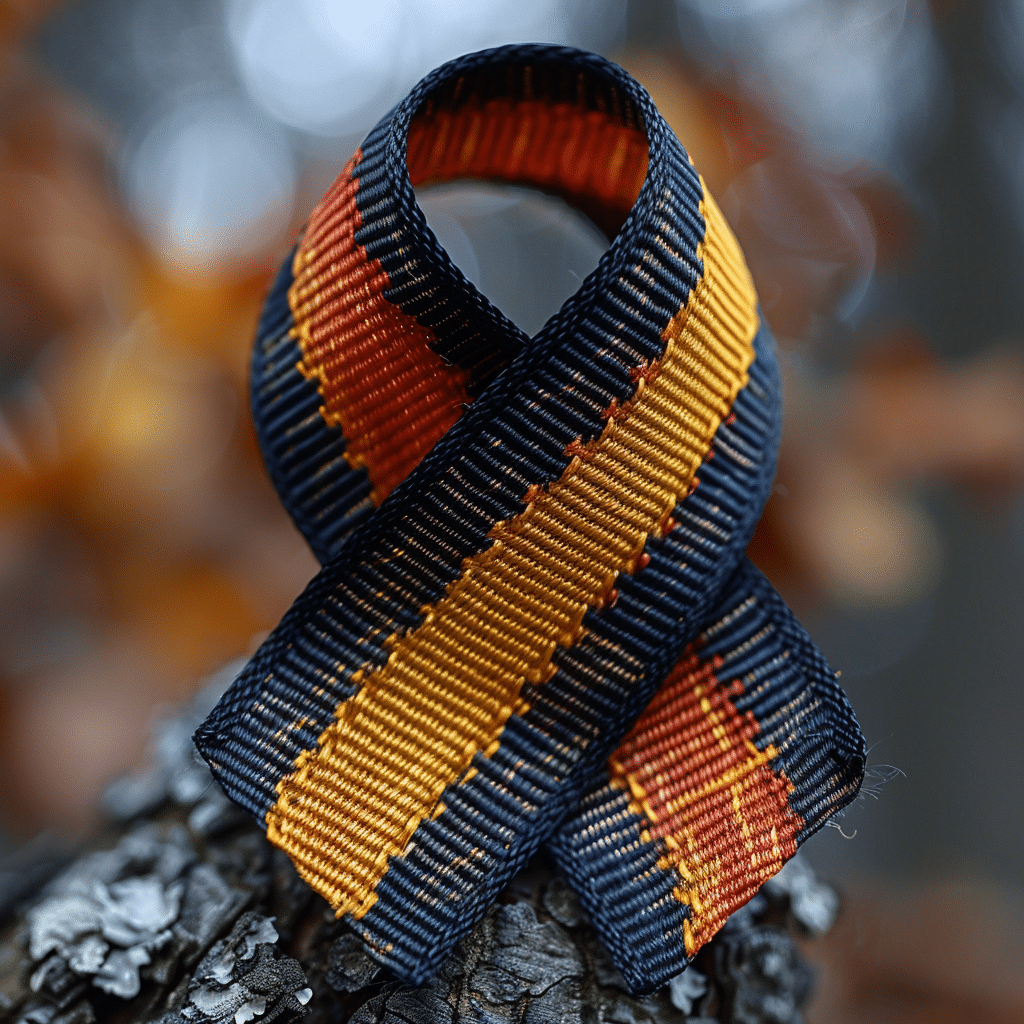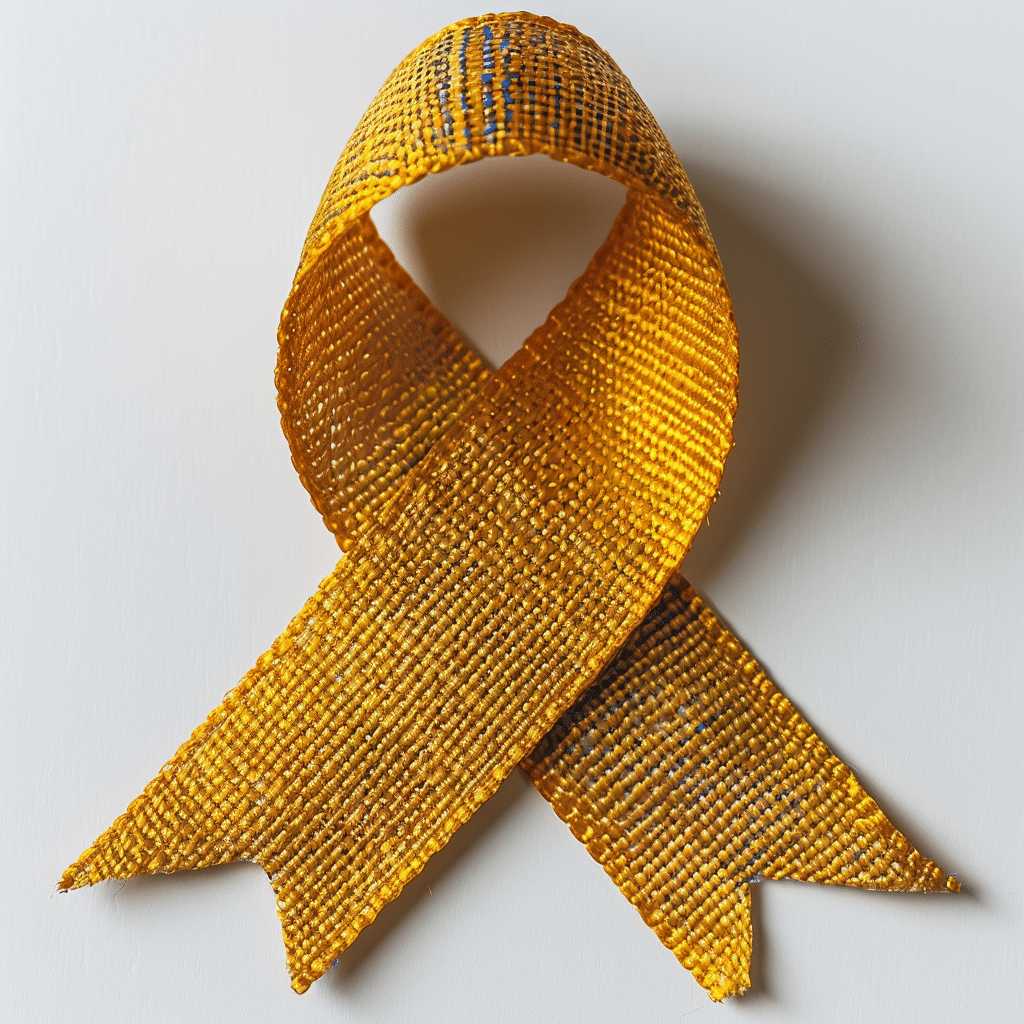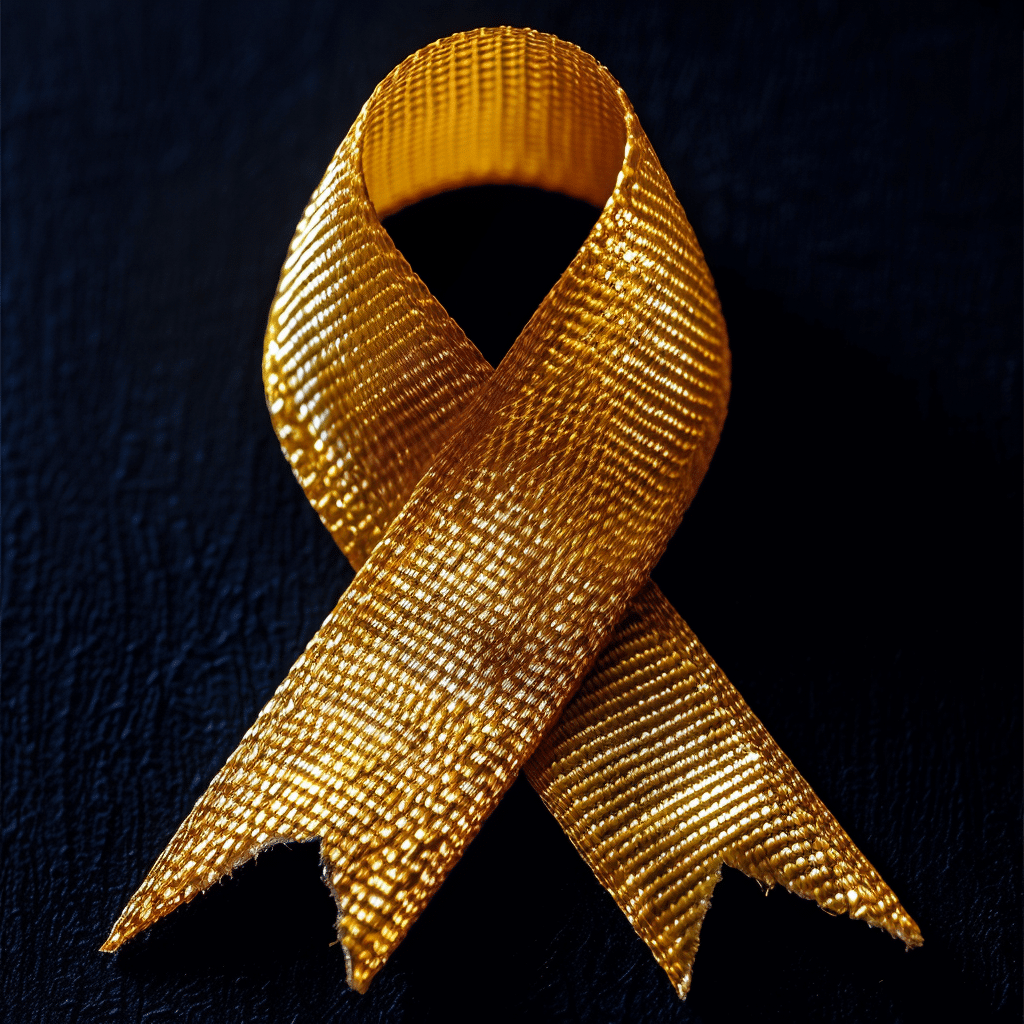The Importance of the Suicide Prevention Ribbon in Advocacy
When it comes to throwing a lifeline to those at the edge of despair, few symbols resonate as profoundly as the suicide prevention ribbon. It’s more than a mere strip of fabric; it’s a banner that flutters with the heartfelt cries of advocacy, a signpost on the long road of mental health awareness. Chosen with care, the ribbon for suicide prevention radiates a promise of solace and a steadfast vow to lift the heavy fog of hopelessness.
To understand its clout, let’s weigh anchor and set sail into the deep meaning of these intertwined colors, for in their hues and textures lies a powerful narrative. They aren’t just splashes of teal and purple; they represent the tears and resolve of countless families who have weathered the storm of loss.
The Emergence of Suicide Awareness Colors in Public Discourse
Picture this: you’re walking down a busy street, and there it is—a tapestry of teal and purple, the suicide awareness ribbon, pinned to the collar of a passing stranger. This small emblem holds a mighty purpose: stitching the fragmented story of mental health into the quilt of mainstream conversation. The adoption and continuity of suicide awareness colors carve out space in public discourse, underlining the subject with the respect and gravity it deserves.
Let’s crack the color code—teal whispers of mental health awareness, a reminder to tread gently around a mind in turmoil. Purple, with its noble hue, honors the dignity of every soul ensnared in the silent battle against their inner demons. Together, these colors aren’t just a pretty duo; they’re a clarion call to remember, to care, to act.

| Title | Description |
|---|---|
| Organization | Yellow Ribbon Suicide Prevention Program (YRSPP) |
| Symbol | Yellow ribbon with a heart |
| Focus | Suicide prevention, particularly among teenagers |
| Founded Year | 1994 (based on historical establishment) |
| Geographic Reach | Primarily United States, with some international recognition |
| National Suicide Prevention Week (NSPW) | Annual week-long campaign in the U.S. to raise awareness about suicide prevention |
| NSPW Date | Typically observed during the week surrounding World Suicide Prevention Day, September 10th |
| Bark Monitoring Tool | – Monitors children/teen’s online activity – Alerts parents/guardians about potential issues like suicidal ideation, depression, self-harm |
| Approach to Suicide Prevention | – Active listening and open communication about feelings and issues – Seeking additional help and ensuring safety if self-harm is a concern |
| Benefits of the Ribbon | – Serves as a visible symbol to promote awareness and conversation about suicide prevention – Represents solidarity and support for those affected by suicide or struggling with depression |
The Teal and Purple Ribbon for Suicide: A Symbol of Solidarity
Ah, the teal and purple ribbon—a beacon that shines in the murkiness of despair. Organizations like the American Foundation for Suicide Prevention (AFSP) and institutions such as the World Health Organization (WHO) embark on this quest, standing shoulder to shoulder with each tear-stained face that looks to them for guidance.
For instance, during National Suicide Prevention Week (NSPW), the air is thick with compassion, as communities lace their towns in a tapestry of these poignant suicide prevention colors. These strips of solidarity speak volumes, whispering, “You’re not alone, we’ve got your back.”
Integrating the Mental Health Awareness Ribbon in Support Efforts
But hold your horses—there’s more to this story. The green ribbon, a cousin to the suicide ribbon, unfurls into a broader landscape of mental well-being. With every crisscross of these ribbons, the narrative evolves, painting a picture where early bird interventions swoop in to save the day before tragedy can unfurl its wings.
Initiatives like those from Mental Health America underline that understanding the full spectrum of mental health is akin to holding both the map and the compass in the quest to prevent self-harm. It’s an invitation to everyone to join the dance and twirl the mental health awareness ribbon proudly, because it’s only together that we can make the music of change truly resonate.

The Importance of Free Pictures Upsetting a Black Family in Awareness Campaigns
Let’s paint a raw, unfiltered portrait capturing the undiluted pain of a family in distress—imagine viewing free pictures of an upset black family struck by mental illness. Every furrowed brow, every downturned mouth tells a story that crosses boundaries, uniting us in our shared human experience. In this canvas, diversity is not just an optional extra; it’s a cornerstone, a building block in the architecture of awareness.
These images, poignant and arresting, serve as a rallying cry, ensuring voices from every walk of life are heard. Zeroing in on a moment of anguish, they bring to life the emotional earthquakes that shake to the core, similar in weight to the news of an earthquake today in Pakistan Islamabad.
How the Self-Compassion Icon Complements the Suicide Prevention Ribbon
Now, sprinkle a touch of grace with the self-compassion icon—a hand cradling a heart or a soothing light. This tiny symbol partners with the suicide ribbon in a dance of hope, persuading those haunted by shadows to step into the glow of self-care. Remember, for the soul scarred by mental skirmishes, warmth can melt away the icicles of fear.
Campaigns harness these icons to weave narratives of strength and survival, much like the messages carried by angel numbers like 1212. They serve as daily bread for the weary traveler on the road to recovery, a reminder that darkness, like the deepest cocoon, ushers in transformation when approached with a tender hand and heart.
Creative and Respectful Ways of Using the Suicide Awareness Ribbon
Now, let’s don our thinking caps and brainstorm—how can we stitch the suicide awareness ribbon into the colorful fabric of society? Here’s where creativity steps in, a dauntless hero ready to infuse fresh life into age-old symbols. From Instagram stories that blaze across cyberspace to murals that turn drab walls into canvases of hope, the suicide ribbon is spinning a story that catches every wandering eye.
Take the initiative of Project Semicolon, where tattoos punctuate the skin, not as full stops, but as commas in an ongoing sentence of survival. Or the shared anon Images and broken heart Png that trickle through the veins of the internet, spreading solidarity with a few clicks and taps.
Preventing the Trivialization of Suicide Prevention Colors and Ribbons
But hold your horses! Let’s not forget that with visibility comes responsibility. We must build a moat around the solemnity of our cause, ensuring our symbols don’t become just another accessory. As custodians of the message, we must tirelessly work to dodge the bullets of commercialization and keep the suicide prevention colors revered, wrapped in the respect they rightfully deserve.
Think of it like tending to a garden—care for each plant, and guard against weeds that might choke the life out of your blooms. Awareness is the sunshine, but intention—pure and focused—remains the nutrient-rich soil.
Strengthening Our Commitment Through Visible Symbols
Wearing the suicide prevention ribbon is akin to sewing a patch in the quilt of our shared humanity, binding us together with threads of empathy and resolve. The colors etched on fabric become conversational keystones, pillars that uphold the structure of dialogue, education, and change.
So, let’s raise our ribbons high, share the images that shake the soul, engage in chatter that matters. It’s about more than just blending in with the crowd; it’s about stepping up, akin to finding big parks near me for a breath of fresh air in a congested world. Every ribbon tied, every picture shared, sews another safety net beneath the tightrope of life.
As we wrap up this tapestry of thoughts, remember—the correct suicide prevention ribbon is no trivial pick from a hat. It’s the echo of our collective hearts—a chorus that sings of understanding, caring, and taking a stand. Through our symbols, we pledge allegiance not to a flag but to the fragile, beautiful essence of life itself. Let’s keep these colors flying high, as beacons that guide lost ships back to harbor, back home.
Fun Facts About the Suicide Prevention Ribbon
A Colorful History
Hold onto your hats, because we’re about to dive headfirst into the intriguing world of the suicide prevention ribbon! Now, the ribbon isn’t just any old piece of fabric; it’s a beacon of hope and a symbol of solidarity. Painted with the hues of yellow and orange, the ribbon glows with optimism. Believe it or not, the choice of color could be seen as a metaphor for a sunrise, an emblem of new beginnings and the light after darkness. Though, let’s be real, the selection process probably wasn’t swayed by reports of an earthquake today in Pakistan Islamabad; but the resilience of those facing adversity, as symbolized by the ribbon, is certainly as powerful as the steadfast strength displayed by communities impacted by such events.
Unraveling the Mystery
And here’s a twist for ya: did you know the ribbon’s inception might have had a sprinkle of destiny to it? Some folks might glance at their watches and mutter about coincidence, but stumbling upon the 1212 angel number could be a wink from the universe for hope and guidance. Now, the creation of the suicide prevention ribbon wasn’t a result of a supernatural sign, but its emergence did bring an otherworldly comfort to many.
Transitioning to a darker note, it’s crucial to acknowledge the struggles that often go hand-in-hand with mental health issues. The ribbon doesn’t shy away from the hard stuff, like facing the downhill slope of a cocaine comedown. It’s a tangible reminder that the journey to recovery isn’t a lonely one, even if someone feels as isolated as a homeowner sifting through Afc home club reviews, searching for that lifeline in their hour of need.
Now, let’s not beat around the bush: the topic of suicide isn’t pretty, and real talk—Pictures Of suicide can be downright harrowing. But don’t let that scare you off because that’s exactly why the suicide prevention ribbon exists. It’s a symbol that cuts through the noise, saying loud and clear,You’re not alone, we’re in this together! And isn’t that something worth wrapping our hearts around?

Is the yellow ribbon for suicide?
Yes, the yellow ribbon is used as a symbol of support for suicide prevention. It’s part of the Yellow Ribbon Suicide Prevention Program which focuses on helping teenagers in the U.S. The program uses this symbol to spread awareness and provide resources to those at risk for suicide.
What is National Suicide Prevention Week?
National Suicide Prevention Week is an annual event where organizations and individuals come together to raise awareness about suicide prevention. The campaign shares resources, stories, and information on how to identify and help those who may be at risk of suicide.
What is bark suicide prevention?
Bark is a service that monitors various online activities and sends alerts to parents or guardians if potential issues like suicidal thoughts, depression, or self-harm are detected in a child’s or teen’s communications.
What do you say to a suicidal friend?
When you’re talking to a friend who may be considering suicide, the most important thing is to listen without judgment. Let them share their feelings, show them you care, and remind them that they’re not alone. If there’s a risk of harm, don’t hesitate to seek additional help to ensure their safety.
Who is often first aware of the warning signs of suicide?
Those closest to a person like family members, friends, or co-workers tend to be the first to notice signs that someone may be thinking about suicide. They’re often the ones to observe changes in behavior that could indicate a risk.
Does having suicidal thoughts mean you have depression?
Not necessarily; suicidal thoughts can occur for a number of reasons and are not limited to individuals with depression. Although there is a strong link between depression and suicide, thoughts of self-harm can also arise from other mental health issues, stress, or distressing life events.
What counts as suicidal ideations?
Suicidal ideation refers to thinking about, considering, or planning suicide. It includes a range of thoughts, from a fleeting consideration to a detailed plan.
Can you have depression without being suicidal?
Absolutely, it’s possible to have depression without having any thoughts of suicide. Depression has many different symptoms, and experiencing suicidal thoughts is just one potential aspect.
Can you prevent a suicide?
While not all suicides can be prevented, many can be. It’s critical to stay informed about the warning signs, offer support to those who are struggling, and get professional help when necessary. Community support and access to mental health resources are key in preventing suicide.
Do they call the police if you call the suicide hotline?
No, calling a suicide hotline doesn’t automatically mean the police will be called. These hotlines are there to provide support and help you find resources. However, if there’s an immediate risk of harm, they may take steps to ensure the caller’s safety, which could involve contacting emergency services.
What happens if I text 741 741?
Texting 741741 will connect you to a trained crisis counselor from Crisis Text Line. You’ll be able to text with them anonymously and confidentially about anything that’s on your mind, and they’ll help you work through the situation.
How to cope with suicidal partner?
When coping with a suicidal partner, it’s crucial to support them while also taking care of your own mental health. Encourage them to seek professional help, be there to listen, and ensure that they know they’re not alone in their struggles.
When partner threatens suicide?
If your partner threatens suicide, take it very seriously. Encourage them to speak with a mental health professional immediately and, if you believe they are in immediate danger, don’t hesitate to seek emergency help.
How to get mental help fast?
If you or someone you know needs mental help fast, it’s essential to reach out to local emergency services, a mental health hotline, or go to the nearest hospital emergency room. In many places, calling 911 can also help you get immediate assistance.
When someone is in crisis?
When someone is experiencing a crisis, they may benefit from immediate support from a crisis hotline or text line. In urgent situations, calling emergency services or going to the nearest emergency department ensures they get the help needed as quickly as possible.




























